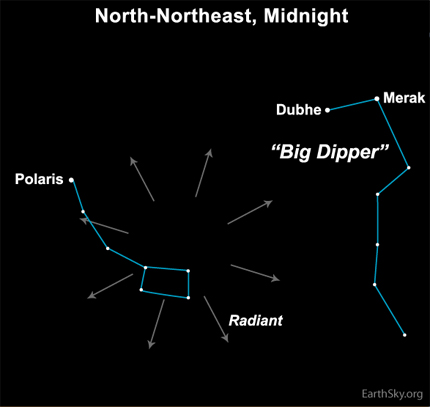2012 Ursid meteor shower active around winter solstice

Tonight for December 19, 2012
EarthSky’s Lunar Phase Calendar is the perfect gift for any sky lover! Order yours today.
Some meteor showers, like the Perseids in August, have been watched each year at the same time for many centuries. But the Ursid meteor shower, which will probably peak on the nights of December 21 or 22, has been observed for only a single century. It was first observed around the turn of the 20th century, when a skywatcher noticed that some meteors seen around this time of year weren’t random in their direction of motion across our sky’s dome but instead appeared to radiate from near the star Kochab in the bowl of the Little Dipper asterism.
Kochab and Pherkad guard the North Celestial Pole
All meteors in annual showers have radiant points on our sky’s dome, and the showers take their names from the constellations in which the radiant points lie. The Little Dipper asterism is in the constellation Ursa Minor the Lesser Bear — hence, the Ursid meteor shower. This shower has been known to produce short bursts of over 100 meteors per hour. But typically the shower is much sparser than that. It might produce only five to 10 meteors per hour at its peak.
EarthSky’s meteor shower guide for 2012
If you want to watch the Ursids, find a country location where you can camp out. Dress warmly! And plan to spend several hours reclining under a dark sky, sometime during the night. Today’s chart, by the way, shows the Big and Little Dippers around 1 a.m. when the Big Dipper is well up in the north-northeast.
The waxing moon obscures the evening viewing of the December 2012 Ursids. But since the radiant point of the Ursid shower will climb upward after the moon sets anyway, we expect the modest Ursid shower to produce the greatest number of meteors between midnight and dawn on Friday, December 22.
Do you love stargazing? Order your EarthSky Planisphere today!
Bottom line: Watch for meteors in the annual Ursid shower beginning around now. The peak is probably around December 21 or 22, but you can see meteors in this shower for several days around the December solstice. As many as 100 meteors per hour have been seen – but only in short bursts. Expect 5 to 10 meteors per hour. The radiant point is in the Little Dipper asterism in the northern sky.

No comments:
Post a Comment